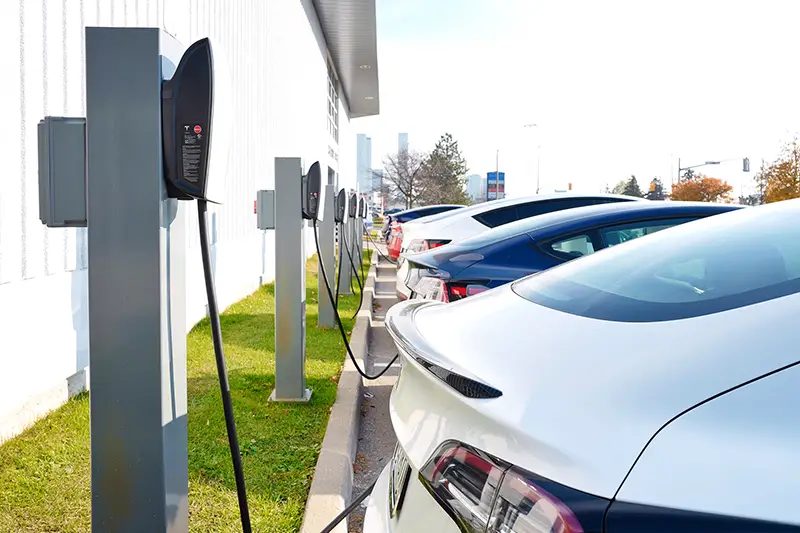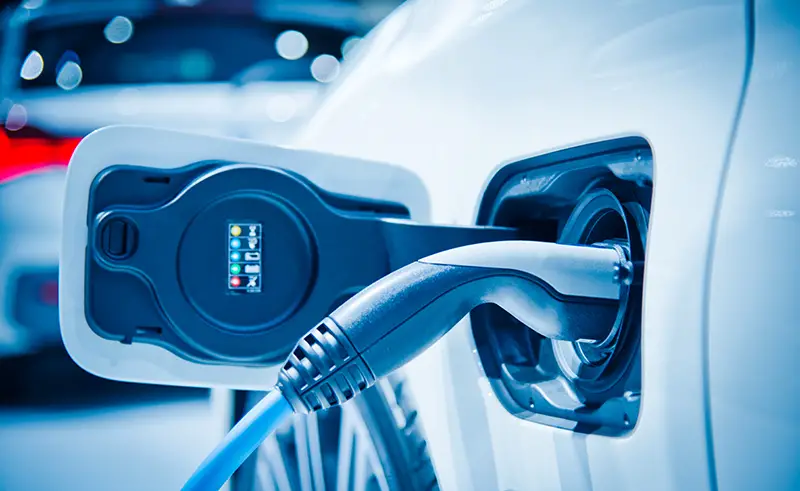Click here to get this post in PDF
Businesses are under continuous pressure to be greener, with customers, employees and the government expecting companies to become more sustainable. One survey revealed that 83% of consumers think businesses should do more to be environmentally sustainable.
Transport emissions are one of the biggest contributors to greenhouse gas emissions in the UK, so providing charging points for employees and customers to top up their EVs (electric vehicles) will help reduce your company’s carbon footprint.
Why businesses are switching to EV workplace charging
The EV revolution is well underway, with 10.6% of all new car registrations in 2021 being electric. The demand for EVs is clear, and soon it will be mandatory for workplaces to install EV charging points. By 2035, all cars and vans sold in the UK must be fully electric.
EVs are the future of transport
The pressure is on for businesses to do more to support EV drivers, and new regulations will soon make workplace charging the norm, as the phase-out date for selling new petrol and diesel cars and vans will start in 2030.
These changes may seem drastic, but they will be supported by a huge investment in infrastructure from the government, with as many as 145,000 charge points being installed across England every year up to 2030. From 2022, new homes, supermarkets, and workplaces will need to install EV charge points.
The issue of finding somewhere to charge a vehicle quickly is being mitigated as well. The government-owned organisation National Highways is investing in Energy Storage Systems for service stations which provide back-up electricity supplies in areas which have a low supply of energy from the grid.
The government has outlined plans to install at least six ultra-rapid charge points in motorway service stations which will allow drivers to charge their vehicle in as little as 15 minutes.
How can businesses benefit from offering workplace charging points?
There are several ways a business can benefit from investing in EV charging points.
1. Appeal to investors
Firstly, setting and reaching sustainability goals can lead to increased investor appeal as consumers are becoming more aware of businesses’ green credentials, and so are investors.
According to a study by the Harvard Business Review 43 out of 70 executives at global investing firms said that environmental, social, and governance (ESG) is now a priority for them and that “corporations will soon be held accountable by shareholders for their ESG performance”.
Making it as easy as possible for employees and customers to charge their vehicles on your business premises demonstrates to investors that you are serious about creating a sustainable and future-proof business.
2. Attract eco-conscious employees and customers
It’s becoming increasingly difficult to find and attract top talent, with experts going as far as saying we’re in a ‘talent crisis’. Your company’s green credentials and sustainability goals, including offering EV charging points,’ can make your company more appealing to potential employees.
One study revealed that individuals aged between 23 and 38 not only make up a third of the global population, but 40% of these individuals chose a job based on how sustainable the company was, and 70% said they would stay at a company which had a strong sustainability plan.
The appeal extends to customers too, so having charging points at your retail stores is a clear indication that you take sustainability seriously. Most Gen Zs prefer to buy sustainable brands and would be willing to spend 10% more on products they knew were sustainable.
3. Help employees and contractors reach net zero targets
Many sustainable businesses are now insisting that their supply chain be carbon free too, so as well as hitting internal lower emission targets, operating a zero carbon fleet and supplying EV charging points on-site can help other businesses reach net zero too.
Many individuals now have EVs to help them reduce their carbon emissions and reach their personal net zero goals. The Department for Business, Energy & Industrial Strategy has a carbon calculator where individuals can work out what they need to do to reduce greenhouse gas emissions and how EVs contribute to this.
How much does installing electric vehicle charging points cost?
As part of the government’s Workplace Charging Scheme (WCS), businesses, charities, and public authorities can claim a maximum of £350 towards the cost of each charging socket, up to 40 sockets. The main caveat to this is that the charging points must be on dedicated off-street parking spaces for staff, fleet, and/or visitors.
If you qualify for funding and have the space available, you could save up to £14,000 on installing a workplace charging station for your commercial vehicles or your employees’ vehicles.
You can find out more about eligibility for this scheme in this document published by the Office for Zero Emission Vehicles (OZEV).
Depending on the type of EV car you choose for your business, or your employees choose for themselves, you could save up to £1,500 on the cost of the car, van, truck, or other vehicles. Certain low-emission vehicles are eligible for this plug-in grant, but they have to be on the list of government-approved cars, which you can view here.
There are also tax incentives in place to encourage companies to invest in EVs and workplace charging points. Company Car Tax (CCT) costs less for zero and ultra-low emission cars and these beneficial rates can save drivers over £2,000 a year. If you’re thinking of upgrading your fleet to electric then the sooner the better as this tax deal is only guaranteed to be in place until March 2025.
The savings you can gain from converting to electric if you have commercial vehicles are immense. Your commercial and employee fuel costs can be reduced by more than £1,000 a year on every 10,000 miles.
How can businesses make the change to EV workplace charging?
Your first step to installing electric car charging stations will be to audit your fleet and survey your employees to find out how many charging points will need to be installed now and potentially in the future.
Once you know this, you can start thinking about the following:
How many EVs do you currently have in your fleet, and/or how many of your employees have EVs?
If you have regular visitors or operate a retail or hospitality business, then you’ll need to consider how many workplace charging points you’ll need to accommodate customers too.
How much space do you have?
If you’re limited by space, then you may only be able to install charging points in certain areas or parking bays.
What type of chargers do you want to install?
There are lots of different options for commercial EV chargers, including twin chargers which can charge two cars simultaneously, making them ideal if you’re short on space. You can find out more about the range of charging points available on the Zap Map website, this website also has a handy map of every EV charging point in the UK.
How much budget do you have?
Even when you factor in the grants you can claim from the government to install charging points, you’ll still need to budget for the costs not covered by these.
How quickly do you want the EVs to charge?
How quickly an EV charges depends on its battery size and how powerful the charge point is. A standard 7kW charge point will be less expensive than an ultra-fast charge point, but they take much longer to charge an EV. There’s more information on the types of charging points available on Love Energy Savings’ Electric Vehicle Charging Solutions page.
The EV charge point installation process
Once you know how many charging points you’ll need, you can apply for the Workplace Charging Scheme.
If successful, you’ll receive a voucher code (valid for 120 days) which you can use with an installer approved by the Office for Zero Emission Vehicles.
Once your installation is complete, the installer will use the voucher to claim the grant through the Workplace Charging Scheme.
The government has published a list of OZEV-approved installers here.
Before any work begins, your installation company will conduct a detailed site survey to see what electrical capacity the site has, as well as look at potential cable routes and the best location for the chargers to be installed.
Installing EV charge points in your workplace supports employees, contractors, visitors, and customers in being greener. There’s plenty of support both from the government, charge point installers, and energy suppliers to make the installation process hassle-free.
To find out more about electric vehicle charging solutions, tariffs, and the Workplace Charging Scheme, visit Love Energy Savings.
You may also like: What You Need to Know About Electric Car Incentives & Market Share in Europe
Image source: Shutterstock.com


